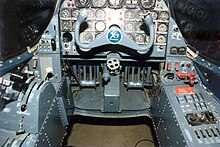Douglas X-3
| Douglas X-3 stiletto | |
|---|---|
 Douglas X-3 "Stiletto" |
|
| Type: | Experimental airplane |
| Design country: | |
| Manufacturer: | |
| First flight: |
October 20, 1952 |
| Commissioning: |
Flight tests ended in 1956 |
| Production time: |
Was never mass-produced |
| Number of pieces: |
1 |
The Douglas X-3 Stiletto was an experimental aircraft that had been built to research aerodynamic effects at speeds of Mach 2 and higher. Furthermore, the construction with the small " stub wings " as well as some new materials like titanium should be tested.
history
Construction of the X-3 began in 1949. Due to the satisfactory results with the Bell X-1 A and the Douglas D-558-I , which were still being tested at that time, the Bell X-2 and the Douglas X-3 should now achieve speeds of up to Mach 3 and the flight behavior be tried out. The X-3 was to take off in the conventional manner and not, like the X-1A and X-2, be launched from modified Boeing B-29 or Boeing B-50 .
The X-3 was equipped with 850 pressure, 150 temperature and 185 load measuring points for the acquisition of measurement data. The fuselage was designed to be extremely long and slim to keep air resistance as low as possible. This “sharp” appearance ultimately earned the X-3 the nickname “Stiletto”. Two copies should be built.
The fact that the planned Westinghouse J47 jet engines with 2,994 kp thrust were not available and had to be replaced by the significantly weaker J34, as its dimensions were similar, led to delays in the test program . This compromise significantly affected the flight performance achieved. The first flight took place on October 20, 1952. The take-off distance was almost 4000 meters. However, since the required speeds could not be achieved with the built-in engines, and the data collected in the subsonic area were also unsatisfactory, it was decided to use the not yet completed second copy of the X-3 only as a spare part carrier.
However, the X-3 program was not entirely in vain: the usability of the short wings was proven; this design was also used in series production in later aircraft, e.g. B. the Lockheed F-104 . The NACA engineers were also able to gather some new knowledge in the field of aerodynamics . The greatest pioneering achievement was made by the X-3 in relation to the tires : Due to the high take-off and landing speeds, important findings were collected that were used in the manufacture of later aircraft and vehicle tires.
NASA dated the last of a total of 51 flights on May 23, 1956.
The X-3 is on display today at the National Museum of the United States Air Force in Dayton , Ohio .
Technical specifications
| Parameter | Data |
|---|---|
| crew | 1 |
| length | 20.35 m |
| span | 6.91 m |
| Max. Takeoff mass | 10,025 kg |
| Top speed | Do 0.95 at high altitude |
| Service ceiling | not specified; the highest altitude flown was about 35,000 feet |
| Range | 800 km |
| Engines | two Westinghouse J34 -WE17- jet engines with 1,905 kp each |
See also
Web links
Individual evidence
- ↑ Description on history.nasa.gov p. 9. (PDF; 1.2 MB) Retrieved on January 11, 2013 .


